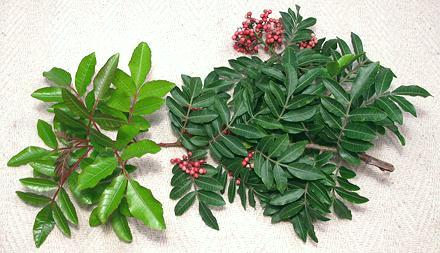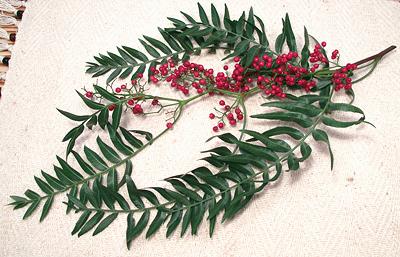 [Schinus terebinthifolius (Brazilian), Schinus molle
(California / Peruvian)]
[Schinus terebinthifolius (Brazilian), Schinus molle
(California / Peruvian)]
These "peppercorns" are from trees of the Cashew family (Anacardiaceae) and are not at all related to the familiar black, green, red and white peppercorns of Southeast Asia, nor to the Sichuan peppercorns of China and Nepal. They have long been used as a spice and medicinally in the Caribbean, and some years back were a real rage with the fancy chef set. During the rage many publications shrilly warned that they were related to poison ivy and poison sumac, but even more so is the spice "sumac" heavily used in the Near East. In any case, dried berries contain no significant amount of the suspected irritants. Today they are commonly found mixed with black, green and white peppercorns in "gourmet" pepper mixes where they serve a decorative purpose only.
Both the Brazilian and Peruvian peppercorns have been used as spice, but it is the Brazilian that's used in the Caribbean. I find those from my trees much sweeter and milder than the Peruvians I get from down at the Bank of America parking lot. The Incas used the Peruvian berries to make fermented beverages and for medicinal purposes.
Pink peppercorns are subtle in flavor and are recommended mostly for fish and mild vegetables like asparagus. Subst: Juniper berries are a good substitute, though stronger so use less.
The photo shows peppercorns from the California / Peruvian pepper tree on
the left and the Brazilian pepper tree on the right, and of course our
ever present red kidney bean is there for scale. These trees are closely
related, but the Peruvian trees grow in the more arid conditions of the Andes
and the Brazilian down in the wet tropics. Both seem to like Southern
California just fine, thank you.
More on Cashews.
 [Florida Holly, Christmasberry, Schinus terebinthifolius]
[Florida Holly, Christmasberry, Schinus terebinthifolius]
Fruits of this tree are used in the Caribbean for both seasoning and medicinal purposes. "Pink peppercorns" from trees growing in Florida were reputed to cause an allergic reaction in some people (throat irritation) so the chefs get their berries from the Caribbean island of Réunion. Whether this is a real problem or just a move to protect a cash crop on Réunion I do not know, but I've had no problem with the ones from my trees here in California.
This low growing tree is extremely invasive in wet climates and almost
impossible to eradicate, particularly a problem in Hawaii and Florida.
It can be told from the California / Peruvian pepper tree by the rounded
tips of its leaves and it's low, dense, even sprawling growth habit. Note
in the photo, new spring growth at the end of the branch with berries on
the previous year's growth.
 [Peruvian Mastictree, Schinus molle]
[Peruvian Mastictree, Schinus molle]
This tree is very common in Southern California and is easy to tell from
the Brazilian Pepper Tree. It grows as a large tree with drooping branches
bearing very long leaves with many narrow sharply pointed leaflets. The
Inca used the berries to make fermented beverages and flavoring syrups.
The tree is also used as a medicinal, but is toxic to some animals and
possibly small children. I get these leaves and berries from the Bank
of America parking lot down on the corner, but find the berries of my
Brazilian pepper trees to be much sweeter and milder. This tree is
drought resistant and is a serious invasive in South Africa and Australia.